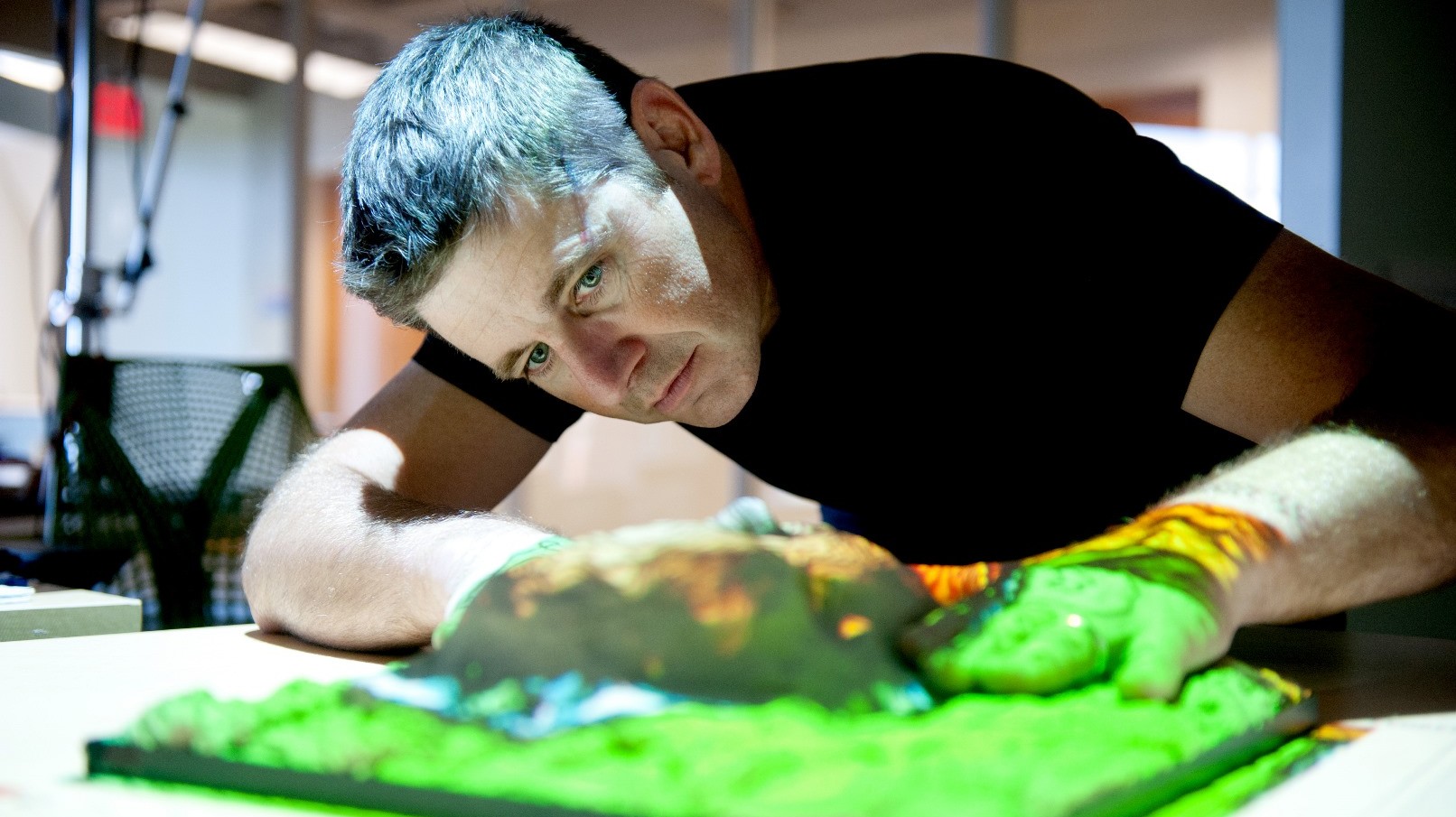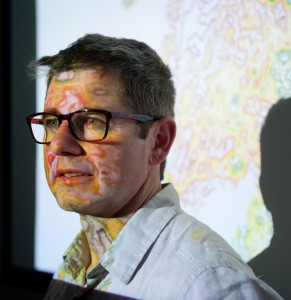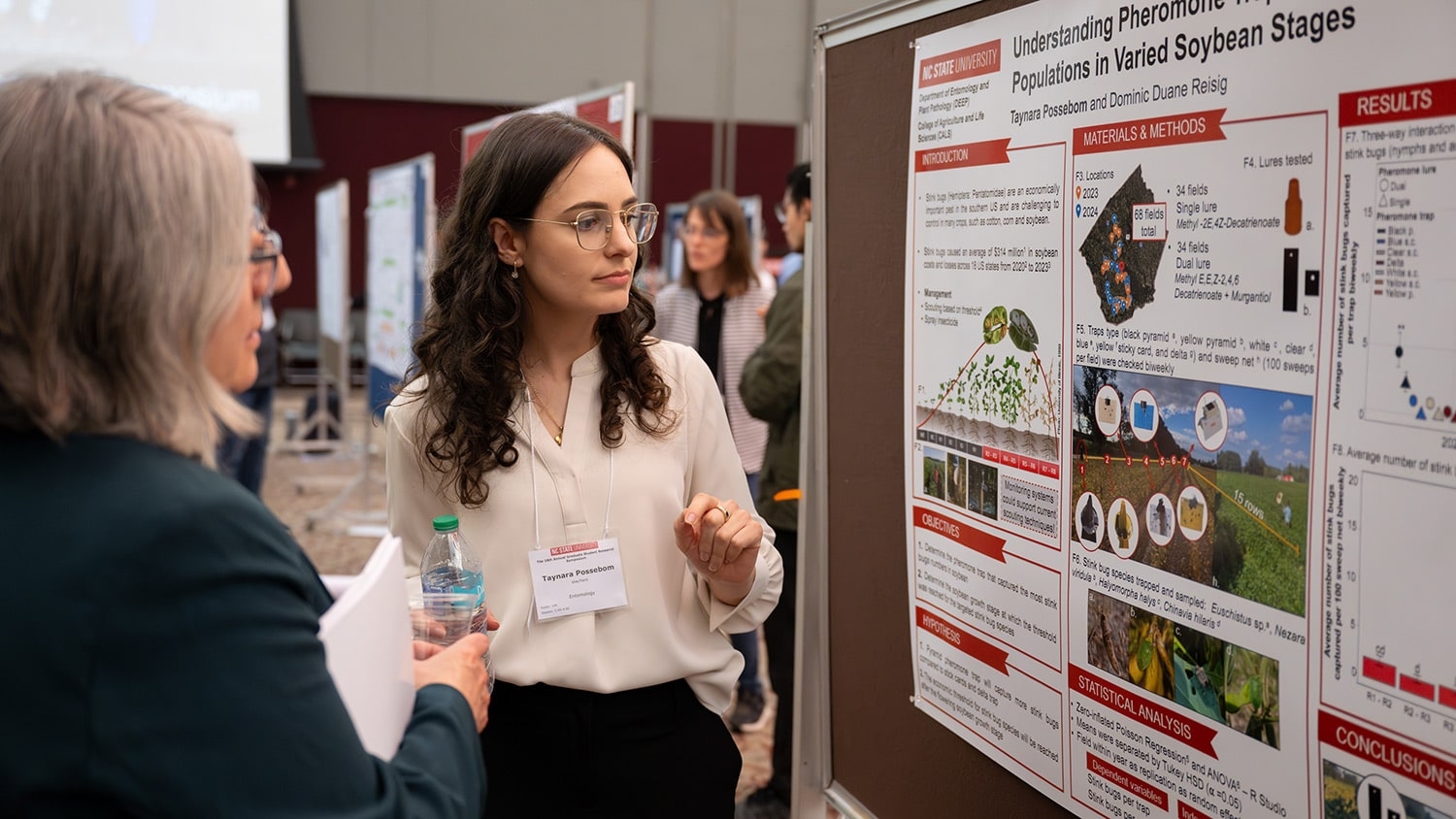Student’s Model Predicts a Better Environmental Future

Douglas Shoemaker, landscape ecologist, is one part pragmatic straight-talker, and one part visionary. He may make a point citing the science fiction film Jurassic Park, or the work of a Nobel Laureate. He is passionately invested in changing both the landscape we know and that of the future, working in what he calls the computational frontier at NC State’s Center for Geospatial Analytics.
Shoemaker tackled the other frontiers before academia. Despite his youthful appearance, he spent years in industry before exchanging a briefcase for a backpack full of books. Then, as now, he was equally invested in the natural world, preferring to cycle rather than drive. He does not fit the traditional mold of doctoral students—for one thing, he is presently the parent of two teenage daughters (ages 18 and 15) as well as a son, age one.
He plans to work as an educator and landscape ecologist when he completes his doctorate next year. His studies integrate ecology, geospatial analysis and time-space modeling. Dynamic spatial-temporal modeling, a tangible component of Shoemaker’s research, investigates urbanization and its impact on socio-ecological systems.
Although the work sounds esoteric, it addresses the pressing issues of our time and influences public policy, Shoemaker explains. Landscape ecology is an evolving science exploring the relationships between environments and ecological processes. Landscape ecologists consider spatial patterns as they occur in different landscapes. They address both research and policy, with an eye to improving them.
Moving from management ranks to addressing the ‘Big Questions of Our Time’
Shoemaker feels a need to reframe our questions about science. He isn’t a dystopian thinker, yet not a utopian either. He merges interdisciplinary studies in ecology, geospatial analysis and time-space modeling, and draws upon the work of economists and philosophers. His extensive experiences in the business world grounded him in practicalities—a perspective he draws upon now. While climbing the tiers of upper management, he worked in northern Virginia and Boston. He “kept running into really smart people” in Boston—meaning, those who were smart and degreed. Shoemaker was smart, successful, but not degreed.
“It bothered me,” he says frankly.
The fact that he had flunked out of undergraduate school rankled Shoemaker, despite his business achievements. He banked enough to return to school at age 39, graduating with honors.
“I finished at University of Massachusetts at Boston in 2003 with a bachelor of science degree in biology, summa cum laude. (But) I had a laugh thinking about my lab partner in Physics II…we had a great time, but he was stunned to discover I was the same age as his dad!” Shoemaker said.
He then entered graduate school at the University of Florida, where he developed a method to measure the amount of climate-changing carbon dioxide absorbed by trees via analysis of satellite images. Shoemaker accepted a research position at UNC-Charlotte’s Center for Applied Geographic Information Science where he met Ross Meentemeyer.
In 2013, Meentemeyer joined NC State’s Center for Geospatial Analytics, and Shoemaker followed and enrolled in a doctoral program. Meentemeyer became his advisor.
“Doug is one of two students working on a new physical user interface that allows anybody to model and visualizes changes in landscapes, a software/hardware framework we call ‘Tangible Landscapes,’” says Meentemeyer. “Think of Google Earth meets the playground sandbox: it scans the sand, and when you push the sand into a hill, that hill appears on the screen and in the map,” he explains.
“Doug is conscious of the interface design. He looks at why is it relevant and practical. He wants to make it easy to investigate whatever variables users think are important in the landscape, and after the system runs, be able to instantly visualize the trade-offs,” he adds. “As scientists, we’re objective and we find multiple solutions to complex problems. Sustainability is not about a single best answer: it’s about trade-offs.”

Shoemaker once enjoyed business and says “I loved time management.” Today, he gets full test of those skills, commuting to Raleigh from Charlotte while keeping a Raleigh apartment and juggling an active family life back in Charlotte. He plans to power through his dissertation and graduate next year. For Shoemaker, a Ph.D. is the ultimate brass ring, now well within his grasp.
He has joined the ranks of the “really smart” people, he jokes.
“On planning the re-entry into academia, I engaged in a ‘limitless’ dream exercise where I asked myself what would I do every day if there were no barriers. After some thought, I settled on a conundrum that had held me, one where my favorite trout hole on a beautiful stream was right next to a road, the valleys being the only place for level roads and the low spot for water,” Shoemaker said.
“The stream was being polluted by MTBE, the ‘winter’ additive for gasoline those days, and I realized that place, and specifically the location of roads and streams relative to each other, had to be understood in order for any successful protection of the water,” he said. “My dream then was to explore the interplay between (physical and built) topographies and ecosystems and report my findings so we as a society could protect our natural heritage.”
At the center they can create precise and organic models, allowing faculty and students to simulate problems as diverse as flooding, or ill-planned urban sprawl. The models use data to precisely and dynamically demonstrate the impact of a proposed highway, for example, or of a controlled burn, or of sea-surge on the coastal regions. Data – in a dynamic form—springs to life, becoming three-dimensional and relatable, rather than pages of charts, algorithms and statistics. Policymakers, for example, can witness authentic demonstrations of ecological impacts and virtual outcomes.
Shoemaker points out that two of North Carolina’s key economic interests, agriculture and tourism, depend upon one basic thing: fertile soil.
“Nothing works unless there is some widespread recognition of the role natural capital plays in our economic systems and our wellbeing. To sustain it, we see the need for fertile soil, clean water,” he says.
Shoemaker’s dissertation concerns the question, “what does a benign landscape look like?” He elaborates, describing his notion of just such an environment.
“We live closer together, we build close to the tops of the hills, not down near the streams and wetlands. We use porous building materials. We process a lot of things on site. We compost. We process waste on site. You could take everyone on the planet and give them a garden apartment, and they would all fit in an area the size of Texas,” he says.
He envisions a world where humankind works towards building the common wealth—or the common good. As a former New Englander, Shoemaker grew up with the everyday idea of a “common wealth” he says, and that has influenced his geopolitical reality.
For Shoemaker, there is an urgent need for different and meaningful discourse about human agency and our environment. In his vision for the future, there is ample room and resources for everyone on planet Earth—that is, if we consider the common good. “Things can happen,” he says with conviction.
Shoemaker mentions a scene in the film Jurassic Park in which a scientist played by actor Jeff Goldblum discusses chaos theory. Goldblum’s character explains that chaos theory “deals with unpredictability in complex systems. The shorthand is the Butterfly Effect. A butterfly can flap its wings in Peking and in Central Park you get rain instead of sunshine.”
Goldblum demonstrates the effect by pouring water onto his hand, showing how the droplets change course. Tiny variations, he explains, vastly affect outcomes.
Shoemaker makes the point that nuanced changes have impact within and beyond complex systems. He also makes the point that “It’s hubris to think that we can control things from the top down.”
He is further frustrated by how poorly scientific matters are related to the public. “I’m well aware that things don’t work well. I battle with science communication,” he says. To succeed as a landscape ecologist, he knows scientists’ work must be viewed by the public as relevant and relatable if a truly benign landscape can occur.
This brings Shoemaker back to the idea of modeling outcomes in demonstrable, tangible ways. It is a useful tool in the hands of a visionary man, because the dynamic models science builds are easily understood by those outside the scientific community. It is a tool for the common good, and can and does influence those beyond the center’s halls.
The center’s research, and Shoemaker’s passion, can shine light—and a better understanding—upon ecological matters for policy shapers and makers, and the public. And offer a healthy dose of hope.
- Categories:


